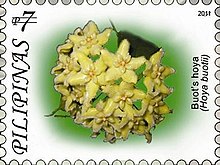Hoya buotii
| Hoya buotii | ||||||||||||
|---|---|---|---|---|---|---|---|---|---|---|---|---|
| Systematics | ||||||||||||
|
||||||||||||
| Scientific name | ||||||||||||
| Hoya buotii | ||||||||||||
| Kloppenb. |
Hoya buotii is a plant of the genus of wax flowers ( Hoya ) of the subfamily of asclepiadoideae (Asclepiadoideae).
features
Hoya blashernaezii is an epiphytic climbing plant with twisting shoots. The light green leaves are thin and petiolate. The leaf blades are elliptical-lanceolate, up to 7 cm long and 3 cm wide. The base is rounded, the apex is pointed. The edges and the pointed tip are curved downwards. The leaf veins emerge only indistinctly. The leaf veins are feathery and branched together. The central rib is slightly sunken and a little darker.
The ball-shaped inflorescence contains 18 to 25 flowers. The flower stalks are up to 3.2 cm long and about 0.12 cm thick. On the surface sit lenticels . They thicken near the calyx. The sepals do not reach as far as the sinuses, which are formed by the petals that are fused at the base. The outside of the sepals is essentially bare. The edges are covered with cilia, the somewhat thickened center is granular. They are 3 mm long and 2 mm wide. The sepals overlap at the base (about 10%). The honey-yellow corolla has a diameter of 2.9 cm when spread out. The petals are fused at the base (about a third). The petal lobes are 1.1 cm long and 0.6 cm wide at the base. They are bare on the outside with a few spots and appear waxy. Inside, it is densely covered with stiff, bristly hairs, with the exception of the area under the secondary crown. The edges and the tips of the tips are bent over. The tips of the deep red secondary crown do not reach the sinuses that are formed by the overgrown petals. The inner, thick, fleshy process is somewhat darker, spatulate-rounded and rises slightly in the center, the outer process is blunt, and dorsally convex and slightly keeled. The anthers are curled in the middle.
The pollinarium is comparatively large with a small corpusculum. The pollinia are 850 µm long and 300 µm wide. The caudiculae are 350 µm long and 30 µm thick. The corpusculum is 270 µm long and the lower half is constricted. The shoulder is 150 µm wide, the waist 80 µm and the hip 100 µm wide.
Similar species
Hoya buotii is close with Hoya leucorhoda Schltr. related, but differs in the sepals covered with cilia, which are also slightly longer (0.3 cm long vs. 0.25 cm long). In addition, the caudiculae are very long, but very short in Hoya leucorhoda . The Pollinia are almost as long as the Pollinia of Hoya meliflua subsp. fraterna T.Green, but the corpusculum is much smaller. In this respect, Hoya buotii comes close to the species Hoya lacunosa . According to Somadee and Kühne, Hoya halconensis is said to be similar, but differ in the smaller flowers.
Geographical distribution and habitat
The species is so far only known from the type locality on Mount Banahaw in Quezon Province, Luzon , Philippines.
Taxonomy
The taxon Hoya buotii was described by Robert Dale Kloppenburg in 2002. The holotype is kept in the herbarium of the University of the Philippines in Los Baños , Laguna Province , Philippines under the number # 67049. The species is named after Inocentio Buot. The Plants of the World online accept Hoya buotii as a valid taxon.
literature
- Surisa Somadee and Jens Kühne: Hoya 200 different wax flowers. 96 p., Formosa-Verlag, Witten 2011 ISBN 978-3-934733-08-4 (p. 32)
Individual evidence
- ^ Robert Dale Kloppenburg: Hoya buotii. Fraterna 15 (4): 1-4, 2002. Online at Biodiversity Heritage Library
- ^ Kew Science - Plants of the World online: Hoya buotii Kloppenb.
